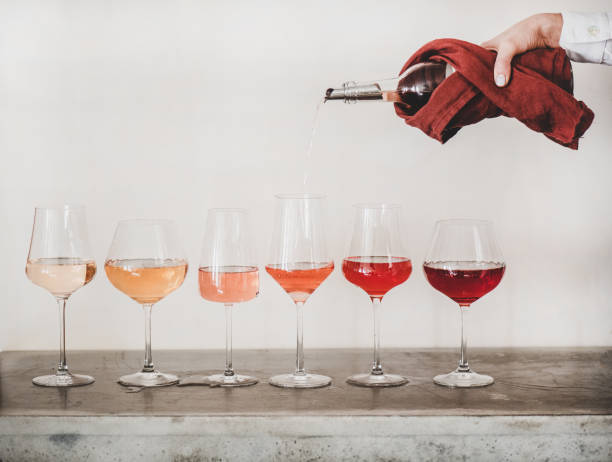Wine production is a delicate art that involves a myriad of factors, from grape cultivation to fermentation and aging. Red wine stabilization is a crucial step in the winemaking process, ensuring that the final product maintains its desired characteristics and quality. In this article, we’ll explore the various techniques involved in red wine stabilization, with a specific focus on the unique process of making White Zinfandel.
Red Wine Stabilization:
Stabilizing red wine is a multifaceted process aimed at preserving the wine’s color, flavor, and aroma while preventing undesirable changes that could occur during production and aging. The primary stabilization techniques include cold stabilization, fining, and filtration.
- Cold Stabilization:
Cold stabilization is a widely used method to prevent the formation of tartrate crystals in wine, commonly known as wine diamonds. Tartaric acid, a natural component of grapes, tends to precipitate in the form of crystals when wine is exposed to low temperatures. These crystals are harmless but can be visually unappealing to consumers.
To perform cold stabilization, winemakers lower the temperature of the wine to just above freezing for a specific period, allowing the tartrate crystals to settle at the bottom of the tank. Once the crystals have formed, the wine is then racked or filtered to remove them. This process ensures that the wine remains visually clear and stable over time.
- Fining:
Fining is another crucial technique in red wine stabilization that involves the addition of fining agents to remove unwanted particles from the wine. Common fining agents include bentonite, isinglass, and gelatin, each of which has specific properties to address different issues.
Bentonite, a type of clay, is effective in removing proteins that can cause haziness in wine. Isinglass, derived from fish bladders, is used to clarify and stabilize wine by removing suspended particles. Gelatin, often derived from animal collagen, can help eliminate both proteins and tannins.
The choice of fining agent depends on the winemaker’s preferences and the specific characteristics of the wine being produced. The fining process enhances the stability and clarity of red wine, contributing to its overall quality.
- Filtration:
Filtration is the final step in red wine stabilization, where the wine is passed through a series of filters to remove particles and microbes. Filtration can be achieved using various materials, such as diatomaceous earth, cellulose, or membrane filters.
Filtration is particularly important for removing yeast cells and bacteria that could lead to off-flavors or spoilage. It also helps improve the wine’s shelf life and stability. Winemakers carefully choose the level of filtration based on the desired style of the wine and the potential impact on its flavor profile.
Making White Zinfandel:
White Zinfandel is a unique and popular style of wine that has gained prominence in the United States. Contrary to its name, White Zinfandel is made from red Zinfandel grapes but undergoes a process that imparts a lighter color and sweeter flavor profile.
- Harvesting and Crushing:
The process begins with the harvesting of fully ripened red Zinfandel grapes. The grapes are then gently crushed, and the juice is separated from the skins to prevent the extraction of deep red pigments and tannins. This initial step is crucial for achieving the characteristic pale pink color of White Zinfandel.
- Cold Fermentation:
To preserve the delicate aromas and flavors of the grapes, White Zinfandel undergoes a cold fermentation process. The juice is fermented at low temperatures, typically between 50-60°F (10-15°C), which slows down the fermentation rate and helps retain the fruity and floral characteristics of the wine.
- Residual Sugar:
Unlike traditional red wines that undergo complete fermentation, White Zinfandel is often left with a small amount of residual sugar. Winemakers halt the fermentation process before all the grape sugars are converted into alcohol, leaving a hint of sweetness in the final product. This residual sugar contributes to the wine’s approachable and fruity profile, making it a popular choice among consumers who prefer sweeter wines.
- Stabilization and Filtration:
While the techniques for red wine stabilization are also applicable to White Zinfandel, there are some variations. Cold stabilization is often employed to prevent the formation of tartrate crystals, similar to red wines. Fining agents may be used selectively, with a focus on preserving the wine’s delicate characteristics.
Filtration is particularly crucial in the production of White Zinfandel to achieve the desired clarity and stability. Since this style of wine is known for its light and refreshing qualities, filtration helps remove any remaining particles that could impact the visual appeal and overall quality of the wine.
Conclusion:
Red wine stabilization is an intricate process that ensures the final product meets the desired quality standards. Techniques such as cold stabilization, fining, and filtration play a pivotal role in maintaining the color, flavor, and stability of red wines.
In the case of White Zinfandel, the artistry of winemaking takes a unique turn. By carefully manipulating the fermentation process, residual sugar levels, and employing specific stabilization techniques, winemakers can create a delightful wine that captivates consumers with its pale pink hue and pleasantly sweet profile. The balance between tradition and innovation in winemaking continues to evolve, offering wine enthusiasts a diverse and exciting range of options to explore and enjoy.




